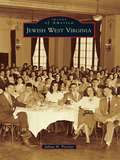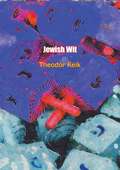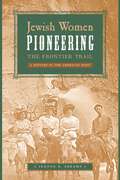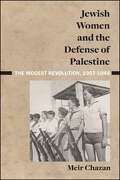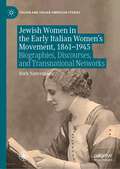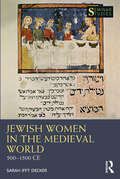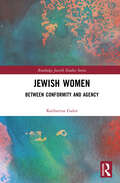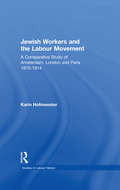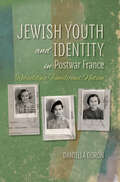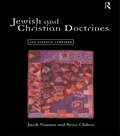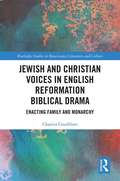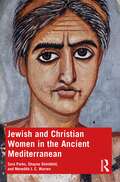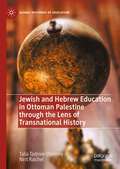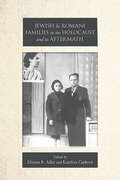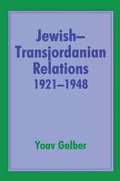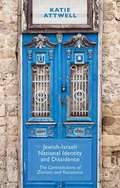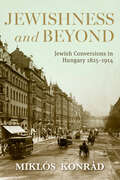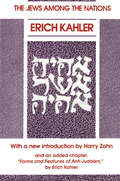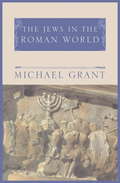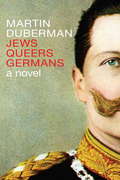- Table View
- List View
Jewish West Virginia (Images of America)
by Julian H. PreislerWest Virginia has a unique history of Jewish settlement dating back to 1849 when the first Jewish organization in the state, a Jewish burial society, was established by a small group of German Jewish immigrants in the city of Wheeling. From modest beginnings, Jews settled in towns and cities and established businesses and communal organizations. Since that time, the Jews of the Mountain State have been an integral part of the state's economic, cultural, and political life. Though always relatively small in size, West Virginia's Jewish population has been a strong advocate for the state and gained prominence in many areas. Readers will recognize images of well-known institutions such as Shoney's, Cohen's, Frankenberger's, Embee's, and others that bring back fond memories. Despite declines in Jewish population numbers, today's Jewish community remains active and involved in the life of the state.
Jewish Wit
by Theodor ReikHere for the first time is a study on the nature of Jewish wit done by one of the greatest psychoanalysts, Theodor Reik. Over twenty years went into the collecting of the material with the result that this book contains.“He (Thedor Reik) is one of the few masters of applied analysis as is shown especially in his earlier contributions, while his later work is more concerned with matters of general psychological interest. In both ways he has given great proof of a high amount of intelligence, criticism and independent thought”—Sigmund Freud
Jewish Wit and Wisdom (Dover Thrift Editions: Speeches/Quotations)
by Herb Galewitz"It's no disgrace to be poor," observed Sholom Aleichem, "but it's no great honor, either." "Happiness is having a large, loving, caring, close-knit family in another city," remarked George Burns, while Marc Chagall noted that "Art is the unceasing effort to compete with the beauty of flowers and never succeeding." These and many more classic examples of Jewish wit and wisdom — sometimes hilarious, frequently profound, almost always incisive — enliven the pages of this entertaining and practical little volume.Some 500 aphorisms include observations and remarks from statesmen, writers, artist, philosophers, jurists, musicians, and celebrities — from the prophets of the Old Testament, the Talmud, and Maimonides to Joey Adams, Barbra Streisand, and Woody Allen. Here also are memorable quotes from Louis Brandeis, Martin Buber, Fanny Brice, Heinrich Heine, Sam Goldwyn, Golda Meir, Karl Marx, Groucho Marx, Herman Mankiewicz, Albert Einstein, and many others.Arranged alphabetically by author, these thought-provoking pronouncements will not only serve as a handy resource for speech writers and public speakers but will also amuse and inspire all readers.
Jewish Women Pioneering the Frontier Trail: A History in the American West
by Jeanne E. AbramsThe image of the West looms large in the American imagination. Yet the history of American Jewry and particularly of American Jewish women—has been heavily weighted toward the East. Jewish Women Pioneering the Frontier Trail rectifies this omission as the first full book to trace the history and contributions of Jewish women in the American West.In many ways, the Jewish experience in the West was distinct. Given the still-forming social landscape, beginning with the 1848 Gold Rush, Jews were able to integrate more fully into local communities than they had in the East. Jewish women in the West took advantage of the unsettled nature of the region to “open new doors” for themselves in the public sphere in ways often not yet possible elsewhere in the country. Women were crucial to the survival of early communities, and made distinct contributions not only in shaping Jewish communal life but outside the Jewish community as well. Western Jewish women's level of involvement at the vanguard of social welfare and progressive reform, commerce, politics, and higher education and the professions is striking given their relatively small numbers.This engaging work—full of stories from the memoirs and records of Jewish pioneer women—illuminates the pivotal role these women played in settling America's Western frontier.
Jewish Women and the Defense of Palestine: The Modest Revolution, 1907–1945
by Meir ChazanThe Jewish women's revolution was one of the quietest and most angst-stricken of the revolutionary processes experienced by Zionism and the Yishuv (the Jewish community pre-1948) in Palestine during the first half of the twentieth century but at the same time one of the most profound and lasting among them. Jewish Women and the Defense of Palestine addresses women's struggle to join defense and military activities during the period between the establishment of the Hashomer organization in 1909 and the outbreak of the War of Independence in late 1947. It describes the battles women fought as they sought to challenge the male assumption that members of the "weaker sex" should not be integrated into defense activities. Moreover, the book analyzes the explicit and self-conscious aspiration of women, especially in the Labor settlement movement, to actively participate in defending and guarding their settlements as part of their broader view of women having an equal right to share the burden of building the Jewish national home in Palestine.
Jewish Women in the Early Italian Women’s Movement, 1861–1945: Biographies, Discourses, and Transnational Networks (Italian and Italian American Studies)
by Ruth NattermannThis book is the first epoch-spanning study on Jewish participation in the Italian women’s movement, focussing in a transnational perspective on the experience of Italian-Jewish protagonists in Liberal Italy, during the First World War and the Fascist dictatorship until 1945. Drawing on ego-documents, contemporary journals and Jewish community archives, as well as records by the police and public authorities, it examines the tensions within the emancipation process between participation and exclusion. The book argues that the racial laws from 1938 did not represent the sudden end of an idyllic integration, but rather the climax of a long-term development. Social marginalization, the persecution of Jewish rights, and the assault on Jewish lives during fascism are analysed distinctly from the perspective of Jewish women. In spite of their significant influence on the transnational orientation of the Italian women’s movement, their emancipation as women and Jews remained incomplete.
Jewish Women in the Medieval World: 500–1500 CE (Seminar Studies)
by Sarah Ifft DeckerJewish Women in the Medieval World offers a thematic overview of the lived experiences of Jewish women in both Europe and the Middle East from 500 to 1500 CE, a group often ignored in general surveys on both medieval Jewish life and medieval women. The volume blends current scholarship with evidence drawn from primary sources, originally written in languages including Hebrew, Latin, Aramaic, and Judeo-Arabic, to introduce both the state of scholarship on women and gender in medieval Jewish communities, and the ways in which Jewish women experienced family, love, sex, work, faith, and crisis in the medieval past. From the well-known Dolce of Worms to the less famed Bonadona, widow of Astrug Caravida of Girona, to the many nameless women referred to in medieval texts, Jewish Women tells the stories of individual women alongside discussions of wider trends in different parts of the medieval world. Even through texts written about women by men, the intelligence, courage, and perseverance of medieval Jewish women become clear to modern readers. With the inclusion of a Chronology, Who’s Who, Documents section, and Glossary, this study is an essential resource for students and other readers interested in both Jewish history and women’s history.
Jewish Women's History from Antiquity to the Present
by Debra Kaplan Elisheva Carlebach Nadia Valman Judith R. Baskin Dianne Ashton Moshe Rosman Marla Brettschneider Dina Danon Rebecca Lynn Winer Natalia Aleksiun Rachel Adelman Benjamin M. Baader Joseph and Esther Foster Professor in Judaic Studies Sylvia Barack Fishman Book Review Editor Federica Francesconi ChaeRan Freeze Tal Ilan Book Review Editor Melissa R Klapper Sharon Koren Frances Malino Renee Levine Melammed Lilach Rosenberg-FriedmanJewish Women’s History from Antiquity to the Present is broad in geographical scope exploring Jewish women’s lives in what is now Eastern and Western Europe, Britain, Israel, Turkey, North Africa, and North America. Editors Federica Francesconi and Rebecca Lynn Winer focus the volume on reconstructing the experiences of ordinary women and situating those of the extraordinary and famous within the gender systems of their times and places. The twenty-one contributors analyze the history of Jewish women in the light of gender as religious, cultural, and social construct. They apply new methodologies in approaching rabbinic sources, prescriptive literature, and musar (ethics), interrogating them about female roles in the biblical and rabbinic imaginations, and in relation to women’s restrictions and quotidian actions on the ground. They explore Jewish’s women experiences of persecution, displacement, immigration, integration, and social mobility from the medieval age through the nineteenth century. And for the modern era, this volume assesses women’s spiritual developments; how they experienced changes in religious and political societies, both Jewish and non-Jewish; the history of women in the Holocaust, their struggle through persecution and deportation; women’s everyday concerns, Jewish lesbian activism, and the spiritual sphere in the contemporary era. Contributors reinterpret rabbinical responsa through new lenses and study a plethora of unpublished and previously unknown archival sources, such as community ordinances and court records, alongside autobiographies, letters, poetry, narrative prose, devotional objects, the built environment, illuminated manuscripts, and early printed books. This publication is significant within the field of Jewish studies and beyond; the essays include comparative material and have the potential to reach scholarly audiences in many related fields but are also written to be accessible to all, with the introductions in every chapter aimed at orienting the enthusiast from outside academia to each time and place.
Jewish Women: Between Conformity and Agency (Routledge Jewish Studies Series)
by Katharina GalorJewish Women: Between Conformity and Agency examines the concepts of gender and sexuality through the primary lens of visual and material culture from antiquity through to the present day. The backbone of this transhistorical and transcontextual study is the question of Jewish women’s agency in four different geographical, chronological, and methodological contexts, beginning with women’s dress codes in Roman-Byzantine Syro-Palestine, continuing with rituals of purity in medieval Ashkenaz, worship in papal Avignon and the Comtat Venaissin, and ending with marriage and divorce in Israeli film. Each of these explorations is interested in creating a dialogue between the patriarchal legacy of the traditional texts and the chronologically corresponding visual and material culture. The author challenges traditional approaches to the study of Jewish culture by employing tools from art history, archaeology, and film and media studies. In each of these different contexts, there is ample evidence that women—despite persistent overall structural discrimination—have found ways to challenge male constructs of gender norms. Ultimately, these examples from past and present times highlight women’s eminence in shaping Jewish history and culture. Bringing a new interdisciplinary lens to the study of the history of gender and sexuality, the book will be of interest to students and researchers of Jewish history and culture, art history, archaeology, and film studies.
Jewish Workers and the Labour Movement: A Comparative Study of Amsterdam, London and Paris 1870-1914 (Studies in Labour History)
by Karin HofmeesterDuring the late nineteenth century, many Jewish workers and intellectuals considered their integration into the general labour movement as a good way to counter the double disadvantage they suffered in society as Jews and workers. Whilst in Amsterdam this process encountered few obstacles, it was more problematical in London and Paris. Through a detailed examination of the collaborative efforts of Jewish labour in these three cities, Jewish Workers and the Labour Movement reveals the multi-layered and unique position of Jewish workers in the labour market. It shows how various factors such as economic change, political upheaval, state intervention and anti-Semitism all affected the pace of integration, and draws conclusions that highlight the similarities as well as the differences between the efforts of Jewish workers to improve their lot in France, Britain and Holland.
Jewish Writing and Identity in the Twentieth Century (Routledge Library Editions: Jewish History and Identity)
by Leon Israel YudkinFrom the 1880s, when systematic pogroms in Russia led to massive emigration, there have been two themes in Jewish history - persecution, culminating in the holocaust, and the corresponding search for a place in the world, which led to emigration to America, the rise of Zionism and the emergence of the State of Israel. In spite of these factors, Jews throughout the world have maintained their sense of identity and their cohesion as a people. One factor which has enabled them to do this has been the formation of an ideological vision of themselves - a sense of Jewishness - and one major way in which this ideology expresses itself is through the contributions by Jews to literature and thought. This book, originally published in 1982 by an established authority on Hebrew and Israeli literature, analyses the characteristics of the Jewish sense of identity as it appears in twentieth-century Jewish literature. It considers the work of a variety of authors who wrote in different periods and countries, and shows how their Jewish background pervades their writing. Some of the authors discussed are Franz Kafka, Osip Mandelstam, Henry Roth, Giorgio Bassani, S.Y. Agnon, Saul Bellow and Norman Mailer. This book will be particularly useful since a complete understanding of the Jews in the twentieth century can only be gained by appreciating their literary and intellectual achievements.
Jewish Youth and Identity in Postwar France: Rebuilding Family and Nation (The Modern Jewish Experience)
by Daniella Doron“Highlights the debates surrounding family and identity as French Jewish communities slowly recovered and reestablished their place in the French nation.” —ChoiceAt the end of World War II, French Jews faced a devastating demographic reality: thousands of orphaned children, large numbers of single-parent households, and families in emotional and financial distress. Daniella Doron suggests that after years of occupation and collaboration, French Jews and non-Jews held contrary opinions about the future of the nation and the institution of the family. At the center of the disagreement was what was to become of the children. Doron traces emerging notions about the postwar family and its role in strengthening Jewish ethnicity and French republicanism in the shadow of Vichy and the Holocaust.“Doron’s book appears at a key moment. Its emphasis on children emerging from hunger, displacement and war should render it standard reading for policymakers, NGOs and others interested in shaping the destinies of today’s abandoned children.” —French History“Raises fundamental questions for the understanding of not only Jewish reconstruction in post-World War II France, but also Holocaust memory, postwar French society and culture and the history of postwar European families and children.” —French Politics, Culture and Society“Doron’s deftly argued and well researched book is an important intervention into a growing body of scholarship on the postwar decade. She convincingly documents the central role that the rehabilitation of Jewish children and the reconstruction of Jewish families played in post-war French Jewish reconstruction and underscores the importance of the decade following the war in shaping Jewish historical evolution in France.” —Maud Mandel, author of Muslims and Jews in France
Jewish and Christian Doctrines: The Classics Compared
by Jacob Neusner Bruce ChiltonJewish and Christian Doctrines presents a concise and lucid introduction to the foundations of Judaism and Christianity. The authors explore key documents ofJudaism and Christianity to elucidate and illuminate the doctrinal issues which the documents raise and to examine the similarities and differences between the two faiths.
Jewish and Christian Voices in English Reformation Biblical Drama: Enacting Family and Monarchy (Routledge Studies in Renaissance Literature and Culture)
by Chanita GoodblattEnglish Biblical drama of the sixteenth century resounds with a variety of Jewish and Christian voices. Whether embodied as characters or manifested as exegetical and performative strategies, these voices participate in the central Reformation project of biblical translation. Such translations and dramatic texts are certainly enriched by studying them within the wider context of medieval and early modern biblical scholarship, which is implemented in biblical translations, commentaries and sermons. This approach is one significant contribution of the present project, as it studies the reciprocal illumination of Bible and Drama. Chanita Goodblatt explores the way in which the interpretive cruxes in the biblical text generate the dramatic text and performance, as well as how the drama’s enactment underlines the ethical and theological issues as the heart of the biblical text. By looking at English Reformation biblical drama through a double-edged prism of exegetical and performative perspectives, Goodblatt adds a new dimension to the existing discussion of the historical resonance of these plays. Jewish and Christian Voices in English Reformation Biblical Drama integrates Jewish and Christian exegetical traditions with the study of Reformation biblical drama. In doing so, this book recovers the interpretive and performative powers of both biblical and dramatic texts.
Jewish and Christian Women in the Ancient Mediterranean
by Sara Parks Shayna Sheinfeld Meredith J. WarrenThis engaging and accessible textbook provides an introduction to the study of ancient Jewish and Christian women in their Hellenistic and Roman contexts. This is the first textbook dedicated to introducing women’s religious roles in Judaism and Christianity in a way that is accessible to undergraduates from all disciplines. The textbook provides brief, contextualising overviews that then allow for deeper explorations of specific topics in women’s religion, including leadership, domestic ritual, women as readers and writers of scripture, and as innovators in their traditions. Using select examples from ancient sources, the textbook provides teachers and students with the raw tools to begin their own exploration of ancient religion. An introductory chapter provides an outline of common hermeneutics or "lenses" through which scholars approach the texts and artefacts of Judaism and Christianity in antiquity. The textbook also features a glossary of key terms, a list of further readings and discussion questions for each topic, and activities for classroom use. In short, the book is designed to be a complete, classroom-ready toolbox for teachers who may have never taught this subject as well as for those already familiar with it. Jewish and Christian Women in the Ancient Mediterranean is intended for use in undergraduate classrooms, its target audience undergraduate students and their instructors, although Masters students may also find the book useful. In addition, the book is accessible and lively enough that religious communities’ study groups and interested laypersons could employ the book for their own education.
Jewish and Hebrew Education in Ottoman Palestine through the Lens of Transnational History (Global Histories of Education)
by Nirit Raichel Talia Tadmor-ShimonyThis book uses transnational history to explain the formation of modern schools in a territory that lacks modern education. The emergence of modern Jewish education in Ottoman Palestine resulted from European actors and networks' infiltration of educational concepts due to several unique elements. One of them was the activity of transnational networks and actors. The other factor is the important place of education in shaping reality in the Jewish and Hebrew discourse. The area of Ottoman Palestine was almost devoid of modern education, so it is possible to examine the ways of transferring educational concepts. Historians can diagnose the starting point and locate the actors’ biographies and journeys. The book discusses and discovers several themes, such as molding five portraits of modern Jewish and Hebrew education graduates and the function of the school as a medical site due to the shortage of public health policy.
Jewish and Romani Families in the Holocaust and its Aftermath
by Eliyana R. Adler Dalia Ofer Sarah Wobick-Segev Laura Hobson Faure Natalia Aleksiun Viktoria Banyai Robin Judd Anja Reuss Helena Sadílková Joachim Schlör Michal Unger Katerina Capková Volha BartashDiaries, testimonies and memoirs of the Holocaust often include at least as much on the family as on the individual. Victims of the Nazi regime experienced oppression and made decisions embedded within families. Even after the war, sole survivors often described their losses and rebuilt their lives with a distinct focus on family. Yet this perspective is lacking in academic analyses. In this work, scholars from the United States, Israel, and across Europe bring a variety of backgrounds and disciplines to their study of the Holocaust and its aftermath from the family perspective. Drawing on research from Belarus to Great Britain, and examining both Jewish and Romani families, they demonstrate the importance of recognizing how people continued to function within family units—broadly defined—throughout the war and afterward.
Jewish-Transjordanian Relations 1921-1948: Alliance of Bars Sinister
by Yoav GelberYoav Gelber traces the relation between the stae of Israel and the Hashemite dynasty of Transjordan by focusing on the connection between the two regions from as early as 1921 when Abdullah first appeared on the scene, and by using Jewish sources as well as British records.
Jewish-israeli National Identity And Dissidence
by Katie AttwellThis unique book provides a critical perspective on identity in questioning how Israeli Jews manage and manifest their concern for the Palestinian Other, eschewing presenting identities as concrete and, rather, examines their creation through discourse. Zionism and the Israeli state have constructed a Jewish national identity premised on demonisation of the Other. This book explores how internal critics use alternative discourses of identity to re-imagine this Jewish-Israeli national identity, and considers how they might fail. It combines a rigorous theoretical analysis of nationalism with an engaging examination of the identifications and contradictions of eleven Jewish-Israeli individuals. Featuring, among others, high profile journalist Gideon Levy, veteran maverick Uri Davis and literary novelist Dorit Rabinyan, Attwell provides a revealing insight into national identity, political dissent, conflict and resistance.
Jewishness and Beyond: Jewish Conversions in Hungary 1825–1914 (Studies in Hungarian History)
by Miklós KonrádThroughout the nineteenth century, Hungary's government steadily dismantled obstacles that kept its rapidly expanding Jewish communities from enjoying the full benefits of citizenship. The state's concerted efforts to "Magyarize" Jews promoted Hungarian language, culture, and sensibilities, but did not officially require Jews to abandon their faith. Nevertheless, tens of thousands of Hungarian Jews converted to Christianity during this era, with conversion rates continuing to rise even as Judaism gained full legal equality.Jewishness and Beyond addresses the apparent contradiction between these two trends. Despite the egalitarian promises and laws of Hungary's liberal nationalist government, the administration and traditional elites as a whole maintained a persistent bias against Jews that spurred particularly high conversion rates among the community's upper echelons. While Christians never forgot converted Jews' origins and increasingly thought of them in racialized terms, they also valued and generally rewarded conversion and the symbolic gesture of baptism. Conversion was an uneven and ever-shifting process in which gender and occupation played key roles, and where the actual percentage of converts within the total Hungarian Jewish population contrasted sharply with both Christian and Jewish perceptions of its frequency and spread.Jewishness and Beyond, which can be read as an introduction to the identity dilemmas of Hungarian Jews in the age of emancipation, reveals the motivations and strategies behind the conversions of Hungarian Jews, the complex reactions within and outside of their communities, and converts' own grappling with conversion's expected and unforeseen outcomes.
Jews Across the Americas: A Sourcebook, 1492–Present (Goldstein-Goren Series in American Jewish History)
by Adriana M. Brodsky and Laura Arnold LeibmanAn overview of the history of American Jewry using primary sources from Latin America, theCaribbean, Canada, and the United StatesJews Across the Americas is a groundbreaking sourcebook capturing the historical diversity and culturalbreadth of American Jews across Latin America, the Caribbean, Canada, and the United States. Featuringprimary documents as well as scholarly interpretations, Jews Across the Americas builds upon newdevelopments in Jewish Studies, engaging with transnationalism, race, sexuality, and gender, andhighlighting the lived experiences of those often left out of Jewish history.Jews Across the Americas features an impressively broad and far-reaching range of historical sources,including artifacts and objects that have not previously been featured as integral to Jewish history in theWestern hemisphere. Entries teach readers how to understand everything from wills andadvertisements to sermons, and how to interpret photographs, domestic architecture, and comics.Whether it’s a recipe from Brazil that blends Moroccan and Amazonian foodways, or a text about thefirst non-binary Jew to cross the Atlantic in the eighteenth century, each entry broadens ourunderstanding of Jewish American history.
Jews Among the Nations
by Erich KahlerThis is an augmented edition of a superb volume by one of the foremost analysts of European institutions and ideas. Here the late Erich Kahler turns his attention to the special character of the Jewish people, formed uniquely through the interaction of internal and external circumstances in which past and present merge.The chapters in this book deal with persistent problems of Jewish identity. Kahler claims these can be fully understood only by awareness of the close interconnection between the singular ethnic nature and the unique social structure of the Jewish people. He discusses the Jews in Europe, specifically the historical implications of a strict tribal ritual that yet permitted the widest spiritual scope.The second half of the book concerns anti-Semitism, in relation to Jews and Germans. How did the German people, seemingly so congenial to the Jews, develop a murderous revulsion against them, ending a long and fruitful symbiosis? Kahler sees this as a parallel to the parricidal rejection of the Jews by the Christian church. His argument is deepened in an added chapter, new to this volume, on the major forms and features of anti-Judaism, 'in which the earlier theme of the universal and the specific are seen as central not only to the inner history of Judaism but also to the specific interaction of Jews and Gentiles throughout social history.
Jews In The Roman World
by Michael GrantIn describing the triangular relationship among the Jews, the Romans and the Greeks, Michael Grant treats one of the most significant themes in world history.Unlike almost all the other subject nations of the Roman empire, the Jews have survived and have maintained a religious and cultural identity that is substantially unchanged. They provide a unique bridge with the ancient world and can bring us into peculiarly close and intimate contact with life in the Roman empire.This book embraces the period in which the Jewish religion assumed virtually its final form, and in which Jews launched their two heroic, but disastrous revolts against Roman rule. This was, moreover, the time when Judaism gave birth to Christianity. Within a century after the death of Jesus, his followers had become completely independent of Judaism. Michael Grant describes the grandeur of the great multiracial Roman empire, beneath whose rule these stirring and unique developments took place.
Jews In The Roman World
by Michael GrantIn describing the triangular relationship among the Jews, the Romans and the Greeks, Michael Grant treats one of the most significant themes in world history.Unlike almost all the other subject nations of the Roman empire, the Jews have survived and have maintained a religious and cultural identity that is substantially unchanged. They provide a unique bridge with the ancient world and can bring us into peculiarly close and intimate contact with life in the Roman empire.This book embraces the period in which the Jewish religion assumed virtually its final form, and in which Jews launched their two heroic, but disastrous revolts against Roman rule. This was, moreover, the time when Judaism gave birth to Christianity. Within a century after the death of Jesus, his followers had become completely independent of Judaism. Michael Grant describes the grandeur of the great multiracial Roman empire, beneath whose rule these stirring and unique developments took place.
Jews Queers Germans: A Novel
by Martin DubermanA breathtaking historical novel that recreates the intimate milieu around Germany's Kaiser Wilhelm from 1907 through the 1930s, a period of great human suffering and destruction and also of enormous freedom and creativity, a time when the remnants and artifices of the old word still mattered, and yet when art and the social sciences were pirouetting with successive revolutions in thought and style. Set in a time when many men in the upper classes in Europe were gay, but could not be so publicly, Jews Queers Germans revolves around three men: Prince Philipp von Eulenburg, Kaiser Wilhelm II's closest friend, who becomes the subject of a notorious 1907 trial for homosexuality; Magnus Hirschfeld, a famed, Jewish sexologist who gives testimony at the trial; and Count Harry Kessler, a leading proponent of modernism, and the keeper of a famous set of diaries which lay out in intimate detail the major social, artistic and political events of the day and allude as well to his own homosexuality. The central theme here is the gay life of a very upper crust intellectual milieu that had a real impact on the major political upheavals that would shape the modern world forever after.From the Trade Paperback edition.
